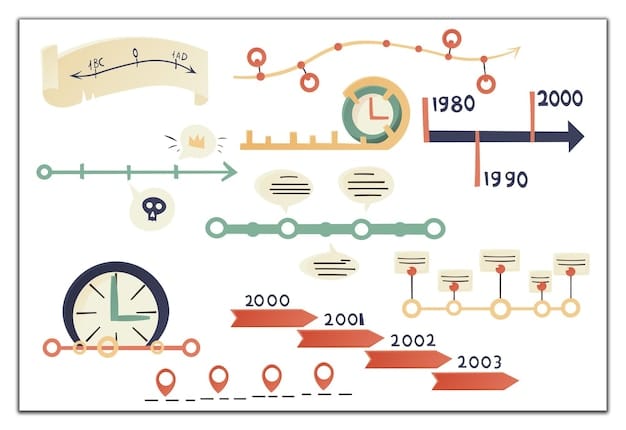Social Security and Inflation: How COLA Protects Your Benefits

Social Security’s annual Cost of Living Adjustment (COLA) is designed to protect the purchasing power of benefits against inflation, ensuring that retirees and other beneficiaries can maintain their living standards as prices rise.
Navigating retirement finances requires understanding how inflation can erode your **Social Security and Inflation: How the Annual COLA Protects Your Purchasing Power**. This article delves into the vital role of the annual Cost of Living Adjustment (COLA) in safeguarding your Social Security benefits against the impacts of rising prices, ensuring a more secure financial future.
Understanding Social Security and Inflation
Inflation, the silent thief of purchasing power, poses a significant threat to the financial well-being of Social Security beneficiaries. As the cost of goods and services increases, fixed incomes can become increasingly inadequate, making it difficult for retirees and individuals with disabilities to maintain their standard of living. Social Security and Inflation: How the Annual COLA Protects Your Purchasing Power is important for maintaining the quality of life for millions of Americans.
Social Security benefits are intended to provide a safety net, ensuring a basic level of income for those who have contributed to the system throughout their working lives. However, without a mechanism to adjust benefits in response to inflation, the real value of these payments would steadily decline over time, leaving beneficiaries vulnerable to economic hardship.

The Impact of Inflation on Social Security Benefits
Inflation erodes the value of money, reducing the amount of goods and services that can be purchased with a fixed sum. For Social Security recipients, this means that the same monthly benefit will buy less and less over time as prices rise.
- Decreased Purchasing Power: Inflation reduces what beneficiaries can afford, impacting their ability to cover essential expenses like food, housing, and healthcare.
- Erosion of Savings: Fixed incomes can be further strained as inflation diminishes the value of savings accounts and other investments.
- Increased Financial Strain: The combination of rising costs and stagnant income can lead to financial insecurity and a lower quality of life for vulnerable individuals.
For example, consider a retiree receiving a Social Security benefit of $1,500 per month. If inflation averages 3% per year, the real value of that benefit will decrease by approximately $45 each year. Over a decade, the cumulative effect of this erosion can be significant, making it increasingly difficult for the retiree to meet their basic needs.
In conclusion, inflation poses a substantial risk to the financial security of Social Security beneficiaries, necessitating a mechanism to protect the purchasing power of their benefits. The annual Cost of Living Adjustment (COLA) serves as this critical safeguard, ensuring that benefits keep pace with rising prices and maintain their real value over time.
What is the Social Security Cost of Living Adjustment (COLA)?
The Social Security Cost of Living Adjustment (COLA) is an annual adjustment to Social Security and Supplemental Security Income (SSI) benefits. Its primary purpose is to counteract the effects of inflation, ensuring that beneficiaries’ purchasing power remains stable despite rising prices. COLA adjustments are typically announced in October and take effect in January of the following year.
The COLA is based on the percentage increase in the Consumer Price Index for Urban Wage Earners and Clerical Workers (CPI-W) from the third quarter of one year to the third quarter of the next. This index tracks the average change over time in the prices paid by urban consumers for a basket of goods and services.
- Annual Adjustment: COLA adjustments occur once a year to reflect the average increase in prices.
- CPI-W Based: The adjustment is calculated using the Consumer Price Index for Urban Wage Earners and Clerical Workers (CPI-W).
- Announced in October: The COLA amount for the upcoming year is typically announced in October.
For instance, if the CPI-W increases by 3% from the third quarter of one year to the third quarter of the next, Social Security and SSI benefits will be increased by 3% starting in January. This adjustment helps beneficiaries maintain their living standards by ensuring their benefits keep pace with the rising cost of goods and services.
In summary, the Social Security Cost of Living Adjustment (COLA) is a crucial mechanism for protecting the purchasing power of benefits against inflation. By adjusting benefits annually based on changes in the CPI-W, COLA helps ensure that Social Security and SSI recipients can continue to afford essential goods and services despite rising prices.
How is COLA Calculated?
Understanding how the Social Security Cost of Living Adjustment (COLA) is calculated involves a clear understanding of the Consumer Price Index for Urban Wage Earners and Clerical Workers (CPI-W). This index is the cornerstone of the COLA calculation, serving as the benchmark for measuring inflation’s impact on consumer prices.
The CPI-W tracks the average change over time in the prices paid by urban consumers for a basket of goods and services, including food, housing, transportation, medical care, and entertainment. The Social Security Administration (SSA) uses the CPI-W to determine the percentage increase in prices from one year to the next.
CPI-W: The Foundation of COLA
The CPI-W is a statistical measure that represents the average change in prices for a specific group of urban consumers. It is calculated by the Bureau of Labor Statistics (BLS), a federal agency responsible for collecting and analyzing economic data.
The Calculation Process
The Social Security Administration (SSA) calculates the COLA by comparing the average CPI-W for the third quarter (July, August, and September) of the current year with the average CPI-W for the third quarter of the previous year. The percentage increase between these two averages determines the COLA for the upcoming year.
- Averaging the CPI-W: The average CPI-W is calculated for the third quarter of both the current and previous years.
- Calculating the Percentage Increase: The percentage increase is determined by subtracting the previous year’s average CPI-W from the current year’s average, and then dividing the result by the previous year’s average.
- Determining the COLA: The percentage increase is then applied to Social Security and SSI benefits, ensuring that they keep pace with rising prices.
In conclusion, the Social Security Cost of Living Adjustment (COLA) is calculated using the percentage increase in the Consumer Price Index for Urban Wage Earners and Clerical Workers (CPI-W) from the third quarter of one year to the third quarter of the next. This process ensures that Social Security and SSI benefits keep pace with rising prices, protecting the purchasing power of beneficiaries.
Historical COLA Rates and Their Impact
Examining historical Cost of Living Adjustment (COLA) rates provides valuable insights into how Social Security benefits have adapted to varying levels of inflation over time. These rates reflect the economic conditions of each year, influencing the financial stability of millions of beneficiaries.
COLA rates have fluctuated significantly throughout history, ranging from periods of high inflation in the 1970s and early 1980s to more moderate increases in recent decades. Understanding these trends is crucial for assessing the effectiveness of COLA in protecting purchasing power.

COLA Rates Over the Years
Historical COLA rates demonstrate how Social Security benefits have responded to different inflationary environments.
- High Inflation Periods: In the 1970s and early 1980s, COLA rates were notably high, reflecting double-digit inflation rates. For example, the COLA for 1980 was 14.3%, one of the highest in history.
- Moderate Inflation Periods: In recent decades, COLA rates have generally been lower, reflecting more stable inflation. The COLA for 2020 was 1.6%, while the COLA for 2021 was 1.3%.
- No COLA Adjustments: In a few years, there was no COLA adjustment because the CPI-W did not increase from the previous year. This occurred in 2010, 2011, and 2016.
These historical COLA rates illustrate the dynamic nature of the adjustment process, highlighting how Social Security benefits adapt to changing economic conditions. By tracking these trends, beneficiaries can gain a better understanding of how inflation affects their financial security and how COLA helps to mitigate these effects.
In summary, historical COLA rates offer valuable insights into the relationship between Social Security benefits and inflation. These rates reflect the economic conditions of each year, influencing the financial stability of millions of beneficiaries and underscoring the importance of COLA in protecting purchasing power over time.
Criticisms and Limitations of COLA
While the Cost of Living Adjustment (COLA) plays a vital role in protecting Social Security benefits from inflation, it is not without its criticisms and limitations. Understanding these issues is essential for a comprehensive view of how well COLA serves its intended purpose.
One of the primary criticisms of COLA is its reliance on the Consumer Price Index for Urban Wage Earners and Clerical Workers (CPI-W). Some argue that the CPI-W does not accurately reflect the spending patterns of older adults and retirees, who tend to have different expenses than younger workers.
Shortcomings of CPI-W
The use of the CPI-W in calculating COLA has several potential shortcomings.
- Different Spending Patterns: The CPI-W may not accurately reflect the spending patterns of older adults, who tend to spend more on healthcare and less on transportation.
- Geographic Variations: The CPI-W is a national average and may not reflect the cost of living in specific regions or cities.
- Substitution Effect: The CPI-W may not fully account for the substitution effect, where consumers switch to cheaper alternatives when prices rise.
Alternatives to the CPI-W, such as the Consumer Price Index for the Elderly (CPI-E), have been proposed as a more accurate measure of inflation for Social Security beneficiaries. The CPI-E focuses specifically on the spending patterns of older adults, potentially providing a more precise adjustment to benefits.
In conclusion, while COLA is essential for protecting Social Security benefits from inflation, it is not without its criticisms and limitations. The reliance on the CPI-W, in particular, has been a point of contention, with some arguing that it does not accurately reflect the spending patterns of older adults. Addressing these issues could lead to a more effective and equitable COLA system for Social Security beneficiaries.
Future of COLA and Potential Reforms
The future of the Cost of Living Adjustment (COLA) is a topic of ongoing debate, with various proposals for reform aimed at addressing the limitations of the current system. As economic conditions continue to evolve, it is essential to consider potential changes to COLA that could better protect the purchasing power of Social Security benefits.
One of the most discussed reforms is the adoption of an alternative measure of inflation, such as the chained CPI or the CPI-E. These measures have different methodologies for calculating inflation, which could result in different COLA adjustments.
Potential COLA Reforms
Several reforms have been proposed to improve the accuracy and effectiveness of COLA.
- Switching to Chained CPI: The chained CPI accounts for the substitution effect, where consumers switch to cheaper alternatives when prices rise. This could result in lower COLA adjustments compared to the CPI-W.
- Adopting the CPI-E: The CPI-E focuses specifically on the spending patterns of older adults, potentially providing a more accurate adjustment to benefits.
- Adjusting the Calculation Frequency: Instead of annual adjustments, COLA could be calculated more frequently to better reflect real-time changes in prices.
These potential reforms could have significant implications for Social Security beneficiaries, affecting the amount of their annual COLA adjustments. Proponents argue that these changes could lead to a more sustainable and equitable system, while critics express concerns about the potential impact on benefit levels.
In summary, the future of COLA is subject to ongoing discussion, with various proposals for reform aimed at addressing the limitations of the current system. As economic conditions continue to evolve, it is essential to consider potential changes to COLA that could better protect the purchasing power of Social Security benefits.
| Key Point | Brief Description |
|---|---|
| 📈 Inflation Impact | Inflation erodes the purchasing power of fixed Social Security benefits. |
| 💰 COLA Definition | COLA is an annual adjustment to Social Security and SSI benefits to counteract inflation. |
| 📊 CPI-W Calculation | COLA is based on the percentage increase in the Consumer Price Index for Urban Wage Earners and Clerical Workers (CPI-W). |
| 🤔 COLA Reform | Potential reforms include using the chained CPI or CPI-E for more accurate adjustments. |
Frequently Asked Questions
Social Security benefits from inflation?
▼
COLA helps Social Security benefits keep pace with inflation, ensuring that retirees and other beneficiaries can maintain their standard of living as prices rise. It is essential for maintaining financial stability.
Social Security benefits calculated?
▼
COLA is calculated annually based on the percentage increase in the CPI-W from the third quarter of one year to the third quarter of the next. This percentage is then applied to Social Security and SSI benefits.
Social Security Administration (SSA)?
▼
The SSA uses the increase in the CPI-W to determine the annual COLA adjustments. It announces the COLA rate each October, and the new rate takes effect in January of the following year.
Social Security and SSI recipients?
▼
COLA helps Social Security and SSI recipients maintain their purchasing power by ensuring their benefits keep pace with the rising cost of goods and services. This helps them afford essential expenses.
COLA adjustments?
▼
Potential reforms include using the chained CPI or CPI-E, which some argue provide a more accurate measure of inflation for older adults, or adjusting the calculation frequency for real-time changes.
Conclusion
In conclusion, understanding the relationship between Social Security and inflation, and how the annual COLA protects your purchasing power, is crucial for financial planning and security in retirement. While the COLA system has its limitations and faces ongoing debates about potential reforms, it remains a vital mechanism for ensuring that Social Security benefits keep pace with rising prices, safeguarding the financial well-being of millions of Americans.





